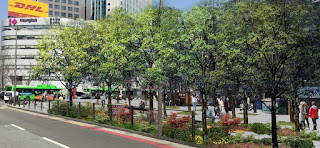 |
| - |
"A series of love letters to Seoul and its many alleyways" (The Korea Times)
"서울과 서울의 수많은 골목길들을 향한 일련의 연애편지" (코리아 타임즈)
"Let's dive into the surreal world built by this urbanism enthusiast (KBS World Radio)
"열렬한 도시주의자가 지은 초현실의 세계 속으로의 다이브" (KBS 월드 라디오)
"열렬한 도시주의자가 지은 초현실의 세계 속으로의 다이브" (KBS 월드 라디오)
Now adapted into movies as 'Seoul Urban Legends'
I've walked through all of Seoul's 600+ neighborhoods, and you've come across a significant number of them in this excuse for a blog, but today, you're invited to my fictional Seoul.
Welcome to my 'Seoul Villages' ('서울 마을들'), a collection of 12 Seoul 'dragedies', among which 'Year Of The Dog', and 'Guisin-dong', and a few short stories initially published in French. Don't
try to escape this ghost neighborhood, don't waste your energy tearing
off that plant, and don't even think about catching Korea's most elusive
shaman: you just can't shake off death. So let this fictional Seoul
claim your soul.
=> download for free 'Seoul Villages' along with my other free ebooks 'on Google Play Books: https://books.google.com/books?id=LwHeDwAAQBAJ.
=> (UPDATE 202204 - Now in French!) 'Seoul Villages' en Francais, egalement a telecharger gratuitement sur Google Play Books: https://books.google.com/books?id=Gc9qEAAAQBAJ, ou a lire en ligne sur Neovel.
=> (UPDATE 202305 - Now in Korean!): read / download "서울 마을들" for free on Google Play Books the Korean Edition (KR - https://play.google.com/store/books/details?id=tke-EAAAQBAJ) or the Bilingual Edition English-Korean (EN-KR - https://play.google.com/store/books/details?id=dV6-EAAAQBAJ)
=> Check my website for my other books (NB y compris en français).
=> Check my website for my other books (NB y compris en français).
Your feedback and reviews are welcome (e.g. on Google Play Books, on Amazon, on Goodreads, on Neovel, on my dragedies website...).
Stephane - April 2020
Seoul Village 2020
Welcome to our Korean Errlines! Follow Seoul Village on Facebook and Twitter, follow me on Instagram.
NEW: download 'Seoul Villages', my collection of short stories (free ebook)
Seoul Villages, the map:
- Crossroads and forking paths - a foreword by Mr. Ho
- Seoul Village(s) - a foreword by the author
- Guisin-dong
- Year of the Dog
- de Vermis Seoulis
- Sweat dream
- Black Snow
- Korean wave
- Tchik!
- Comin'up next
- Seoul Metamorphosis
- (Alleyways – Ogin-dong, Autumn)
- Hunting for Kim Mudangnim
- (Alleyways – Sajik-dong, somewhen)
- Lexicon – Korean terms
'Seoul
Villages' - Copyright © Stephane MOT 2013 - All rights reserved. All
characters appearing in this work are fictitious. Any resemblance to
real persons, living, dead, or beyond those stages, is purely
coincidental. www.stephanemot.com - www.dragedies.com













